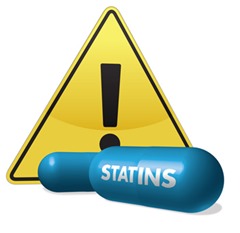 Print This Post
Print This Post
Statin Drugs: The Evil Of A 20 Billion Dollar Industry
Written by Wellness Club on May 25, 2015 – 7:28 pm -By Nurse Mark
Follow The Money
If you ever want to know how or why something bad happens, just follow the money.
Anything that is worth 20 billion dollars a year is sure to have players involved that are careful in safeguarding their interests. Silly, inconsequential things like “the public good” have no place in such industries.
The money is everything.
And so it’s no surprise that research critical of something as profitable as statin drugs rarely ever sees the light of day.
Researchers that dare to challenge the statin industry often find that their next research project is more along the lines of personally discovering the joys of flipping burgers on the late shift. You can be sure that there will never be grant money again for such rebels…
We have written before about the dangers of statin drugs and the near-religious fervor with which statin proponents in Big Pharma and Big Medicine (which are really one in the same) protect this cash-cow drug.
Buried Research
Here is a research paper that we are betting you’ll never hear about anywhere else.
Two researchers in Ireland mined the conventional medical literature sources of Pubmed, EMBASE and the Cochrane review databases for articles about cardiovascular care and statin side effects. What they found was not pretty.
Their paper, titled “The Ugly Side of Statins. Systemic Appraisal of the Contemporary Un-Known Unknowns” concludes (in part):
These finding on statin major adverse effects had been under-reported and the way in which they withheld from the public, and even concealed, is a scientific farce.
Ouch!
Some Of Their Findings:
For every 10,000 people taking a statin, there were:
- 307 more patients with cataracts
- 23 additional patients with acute kidney failure
- 74 extra patients with liver dysfunction
Playing the percentages:
- statin therapy increased muscle fatigue by 30%
- statin therapy at higher doses resulted in rhabdomyelosis in 11.3% of users
Be Afraid Young Man!
Nothing strikes fear into the heart of a young man (or a man at any age) more than erectile dysfunction, which was found to be 10 times more likely to occur in young men taking even the lowest dose of statin drugs.
The ray of sunshine? When statins were stopped over 50 percent had full recovery within 6 months.
The others? Good question…
It’s A Choke
While searching through the FDA Adverse Event Reporting System database the researchers found that for every 10,000 reports of a statin-associated adverse event, approximately 40 reports were for statin-induced interstitial lung disease – a condition that can lead to devastating, even deadly, Pulmonary Fibrosis.
This Is Not So Sweet
The U.S. Veterans Affairs healthcare system is as “conventional” as they come. Still, a V.A. study on 15 million veterans in 10 hospitals in the southern US found that statins affect fasting and postprandial (after eating) glucose levels by causing hyperglycaemia (high blood sugar) in diabetic as well as non-diabetic patients.
Another major study showed a significantly increased risk of developing hemoglobin A1c readings of greater than 6% in both diabetics and non diabetics.
Other researchers have demonstrated that statin drug therapy can cause insulin resistance.
Women, Heed This
Another highly-regarded study, the JUPITER study, showed that statin therapy can cause full blown type 2 diabetes in women.
A recent study from the Womens Inititative looked at 153 840 post-menopausal women without diabetes. Following these women over a number of years found that 10,242 developed diabetes.
Statin use was associated with an increased risk of diabetes and this association remained after adjusting the data for other potential causes and it was seen with all types of statin medications.
Senior Moments
Researchers found that prescribing a statin to seniors increases their risk of developing diabetes by 9%.
A Shaky Relationship
Parkinson’s disease strikes fear into the hearts of seniors.
A strong association between lower cholesterol levels and increased risk of Parkinson’s disease has been reported. Researchers found that each mmol/L increase in total cholesterol was accompanied by a 23% decrease in the risk of developing Parkinson’s disease.
Interestingly, the risk reduction was significant in women but not in men.
Statins And Cancer?
One review found that statin therapy increased risk of non-melanoma skin cancers. Another researcher reported that long term statin use was associated with an increased risk of colorectal cancer, bladder cancer and lung cancer.
Other evidence shows an association between the use of statin in patients after kidney transplant and increased risk of developing of squamous cell carcinoma.
The researchers state that “For unknown reasons, since these publications the squamous cell carcinoma [information] has been excluded in all reports from subsequent statin trials. Hmmm…
I See Problems Here…
Cataracts are becoming increasingly common, and people are developing them at younger ages. Why?
Research has found that statin drug users have a 50% probability of developing cataracts at an earlier age than non-statin users, who tend to develop them at a significantly later age.
But This Takes The Prize!
Statin drugs, given to us by Big Pharma with promises of preventing cardiovascular disease, actually have been found to increase the prevalence and the extent of coronary plaque calcification – a major component of cardiovascular disease.
That’s right, a review of research data showed a strong association between statin use and the progression of coronary artery plaque. Oops…
What’s more, The Veteran Affairs Diabetes Trial found that statin use was linked to accelerated progression of Coronary Artery Calcification (CAC) in participants with Type 2 Diabetes without previous coronary artery disease, despite the fact that the statin users had significantly lower and nearly optimal LDL-cholesterol levels.
Could It Get Any Worse For Statins? Yes, Yes It Could.
Statin drugs activate the Atrogen-1 gene which causes muscle atrophy, wasting and damage.
The heart is a muscle – perhaps the most important muscle in your body!
Statin induced cardiomyopathy (damage to the heart muscle) is the result of statin-induced coenzyme q10 deficiency and statin-induced Atrogen-1 activation.
The Bottom Line?
Cholesterol is crucial for energy, immunity, fat metabolism, leptin (the hunger/satiety hormone), thyroid hormone activity, liver health, stress tolerance, adrenal function, sex hormone synthesis and brain function.
Do we really think it wise to tamper with our body’s own regulatory mechanisms in order to force our cholesterol levels to conform to some artificial standard?
Perhaps we might be better served to address the causes for our epidemic of “metabolic syndrome” and “high cholesterol levels” that seem to have come along with it.
Poor diet, lack of exercise, stress, toxins, all these things affect our finely balanced human system – what we medics call “homeostasis.”
To learn more about how to help your body support healthy cholesterol levels, please visit our webpages discussing Self-Help for High Cholesterol here and here and be sure to read our previous HealthBeat News articles on both statin drugs and cholesterol.
Learn more about the vital substance cholesterol in The Truth About Cholesterol Pt.I and The Truth About Cholesterol Pt.II
Finally, has your conventional doctor used the words “ticking time-bomb” or something similar in trying to get you to accept a a prescription for a statin drug? Yes? Run, don’t walk, away from it! And contact Dr. Myatt for a Brief Telephone Conversation to learn what your options really are.
Reference:
This article is a synopsis for lay readers of an original research paper. The original paper is fully referenced and is available for review by interested readers:
Sherif Sultan, Niamh Hynes: The Ugly Side of Statins. Systemic Appraisal of the Contemporary Un-Known Unknowns.
Open Journal of Endocrine and Metabolic Diseases, Vol. 3 No. 3 (2013) , Article ID: 34065 , DOI:10.4236/ojemd.2013.33025
Related Posts
 Print This Post
Print This Post

Posted in Cholesterol, Drugs and Alternatives | Comments Off





































